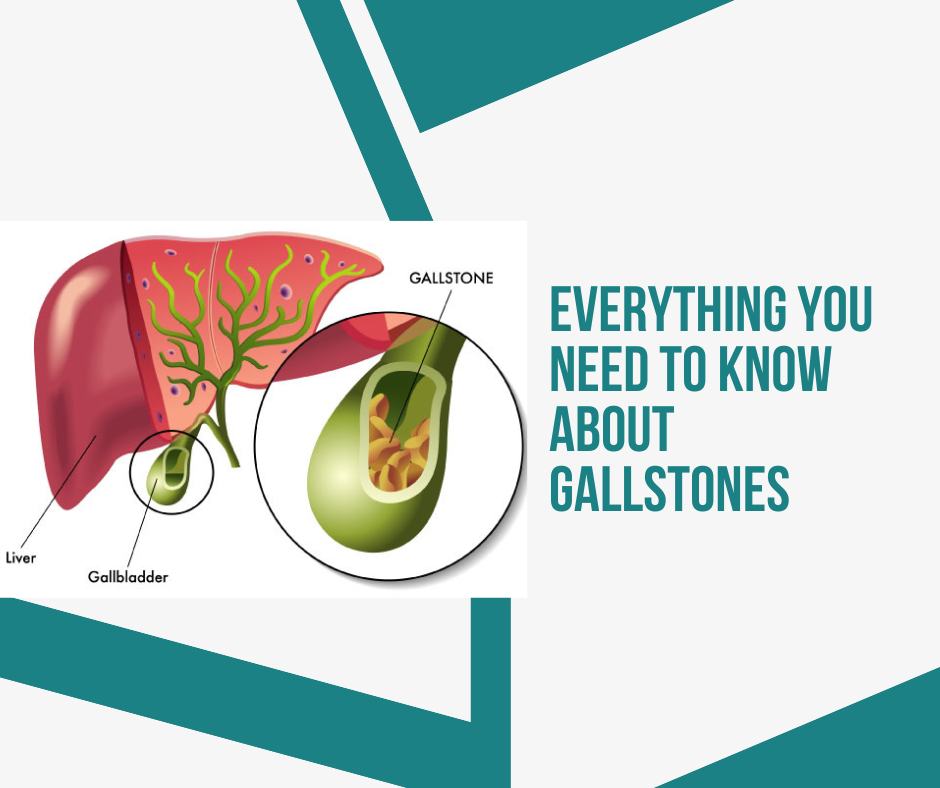Gallstones are solid particles that form in the gallbladder, a small organ located beneath the liver. The gallbladder stores bile, a digestive fluid produced by the liver that helps break down fats. Gallstones can vary in size, ranging from tiny grains to large stones, and can sometimes lead to complications if they obstruct the bile ducts.
Here’s everything you need to know about gallstones:
1. Types of Gallstones
- Cholesterol Gallstones: These are the most common type, made mostly of hardened cholesterol. They form when there is too much cholesterol in the bile.
- Pigment Gallstones: These are smaller and darker, made from excess bilirubin (a substance produced when the liver breaks down red blood cells). They are more common in individuals with liver diseases or certain blood disorders.
2. Causes of Gallstones
- Imbalance in Bile Composition: If the bile contains too much cholesterol, too much bilirubin, or not enough bile salts, it can lead to gallstone formation.
- Obesity: Obesity increases cholesterol production and decreases gallbladder function, which can lead to gallstone formation.
- Dietary Factors: A high-fat, high-cholesterol diet can increase the risk of gallstones.
- Pregnancy: Hormonal changes during pregnancy can increase cholesterol levels in bile and reduce gallbladder emptying.
- Age and Gender: Women, especially those over 40, are at a higher risk. Men can also develop gallstones, but at a lower rate.
- Genetic Factors: Family history plays a role in susceptibility to gallstones.
3. Symptoms
Gallstones may not always cause symptoms, which is referred to as “silent” gallstones. However, when symptoms do occur, they include:
- Pain: Typically in the upper right abdomen or in the center of the abdomen. The pain may be sudden and intense, known as a gallbladder attack or biliary colic.
- Nausea and Vomiting: Often accompanying the pain.
- Indigestion: Especially after eating fatty foods.
- Jaundice: If a gallstone blocks a bile duct, it may cause a buildup of bilirubin, leading to yellowing of the skin and eyes.
- Fever and Chills: These symptoms can occur if a gallstone causes an infection in the gallbladder or bile ducts.
4. Diagnosis
- Ultrasound: The most common and effective way to detect gallstones.
- CT Scan or MRI: Sometimes used to identify complications or provide a clearer image.
- HIDA Scan: This test tracks the flow of bile from the liver to the small intestine and can identify issues with gallbladder function.
5. Treatment Options
- Observation: If gallstones are not causing symptoms, treatment may not be necessary, and the condition is monitored.
- Medications: Some medications can help dissolve cholesterol gallstones, but this is a slow process and not always effective.
- Cholecystectomy: The most common treatment for symptomatic gallstones is surgical removal of the gallbladder, a procedure known as cholecystectomy. This can be done using a minimally invasive technique called laparoscopic surgery.
- Endoscopic Retrograde Cholangiopancreatography (ERCP): This procedure is used if gallstones are blocking a bile duct. It involves using an endoscope to remove or break up the stones.
6. Lifestyle Changes
- Diet: Eating a low-fat, high-fiber diet can help prevent gallstones. Avoiding excessive amounts of cholesterol-rich foods is recommended.
- Regular Exercise: Maintaining a healthy weight and staying active can reduce the risk of gallstones.
- Hydration: Drinking plenty of fluids, especially water, can help maintain healthy bile flow.
7. Complications
- Cholecystitis: Inflammation or infection of the gallbladder, often caused by a blocked bile duct.
- Pancreatitis: Gallstones can block the pancreatic duct, leading to inflammation of the pancreas.
- Cholangitis: Infection of the bile ducts, often associated with a bile duct obstruction caused by a gallstone.
- Gallbladder Cancer: Though rare, long-term inflammation from gallstones can increase the risk of gallbladder cancer.
8. Prevention
- Maintain a healthy weight: Rapid weight loss, such as from fad diets or weight loss surgery, can increase the risk of gallstones.
- Avoid long periods without eating: Skipping meals or fasting can cause the gallbladder to become sluggish.
- Increase fiber intake: A diet rich in fruits, vegetables, and whole grains can help prevent gallstone formation.
9. After Gallbladder Removal (Cholecystectomy)
- Digestive Changes: Without a gallbladder, bile flows directly from the liver into the small intestine, which can sometimes lead to digestive issues like diarrhea, particularly after eating fatty meals.
- Long-Term Outlook: Most people recover fully from gallbladder removal and can live a normal life without it.
In conclusion, gallstones are common and can range from harmless to causing severe complications. Early detection and appropriate treatment, such as lifestyle changes or surgery, can help manage symptoms and prevent serious problems. If you suspect you have gallstones, it’s essential to consult with a healthcare provider for diagnosis and guidance.

